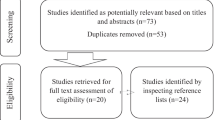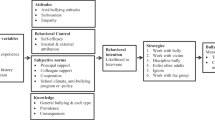Abstract
In this chapter, DeOrnellas and Spurgin describe bullying from the viewpoint of the teacher, noting that teachers vary significantly in how they perceive bullying with some holding complacent attitudes and others taking a proactive stance against bullying. DeOrnellas and Spurgin describe how teachers’ understanding of bullying varies based on level of training, experience, and beliefs regarding bullies and that this, in turn, influences if and how they will intervene. The chapter concludes with focus on effective interventions that teachers can use to handle bullying in their classrooms.
Access this chapter
Tax calculation will be finalised at checkout
Purchases are for personal use only
Similar content being viewed by others
References
Ahn, H.-J., Rodkin, P. C., & Gest, S. (2013). Teacher-student agreement on “bullies and kids they pick on” in elementary classrooms: Gender and grade differences. Theory into Practice, 52, 257–263. doi:10.1080/00405841.2013.829728.
Ahtola, A., Haataja, A., Karna, A., Poskiparta, E., & Salmivalli, C. (2012). For children only? Effects of the KiVa antibullying program on teachers. Teaching and Teacher Education, 28, 851–859. doi:10.1016/jtate.2012.03.006.
Allen, K. P. (2010). Classroom management, bullying, and teacher practices. The Professional Educator, 34(1), 1–15.
Barnes, A., Cross, D., Lester, L., Hearn, L., Epstein, M., & Monks, H. (2012). The invisibility of covert bullying among students: Challenges for school intervention. Australian Journal of Guidance and Counseling, 22, 206–226. doi:10.1017/jgc.2012.27.
Bauman, S., & Del Rio, A. (2006). Preservice teachers’ responses to bullying scenarios: Comparing physical, verbal, and relational bullying. Journal of Educational Psychology, 98, 219–231. doi:10.1037/0022-0663.98.1.219.
Berkowitz, R. (2014). Student and teacher responses to violence in school: The divergent views of bullies, victims, and bully-victims. School Psychology International, 35, 485–503. doi:10.1177/0143034313511012.
Blain-Arcaro, C., Smith, J. D., Cunningham, C. E., Vaillancourt, T., & Rimas, H. (2012). Contextual attributes of indirect bullying situations that influence teachers’ decisions to intervene. Journal of School Violence, 11, 226–245. doi:10.1080/15388220.2012.682003.
Bowllan, N. M. (2011). Implementation and evaluation of a comprehensive, school-wide bullying prevention program in an urban/suburban middle school. Journal of School Health, 81(4), 167–173. doi:10.1111/j.1746-1561.2010.00576.x.
Bradshaw, C. P., Waasdorp, T. E., & O’Brennan, L. M. (2013). Teachers’ and education support professionals’ perspectives on bullying and prevention: Findings from a National Education Association study. School Psychology Review, 42, 280–297.
Burger, C., Strohmeier, D., Sprober, N., Bauman, S., & Rigby, K. (2015). How teachers respond to school bullying: An examination of self-reported intervention strategy use, moderator effects, and concurrent use of multiple strategies. Teaching and Teacher Education, 51, 191–202. doi:10.1016/j.tate.2015.07.004.
Byers, D. L., Caltabiano, N. J., & Caltabiano, M. L. (2011). Teachers’ attitudes towards overt and covert bullying, and perceived efficacy to intervene. Australian Journal of Teacher Education, 36, 105–119. doi:10.14221/ajte.2011v36n11.1.
Carrera, M. V., DePalma, R., & Lameiras, M. (2011). Toward a more comprehensive understanding of bullying in school settings. Educational Psychology Review, 23, 479–499. doi:10.1007/s10648-011-9171-x.
Charmaraman, L., Jones, A. E., Stein, N., & Espelage, D. L. (2013). Is it bullying or sexual harassment? Knowledge, attitudes, and professional development experiences of middle school staff. Journal of School Health, 83, 438–444.
Chen, L.-M. (2015). Self-reported frequency and perceived severity of being bullied among elementary school students. Journal of School Health, 85, 587–594.
Cortes, K. I., & Kochenderfer-Ladd, B. (2014). To tell or not to tell: What influences children’s decisions to report bullying to their teachers? School Psychology Quarterly, 29, 336–348.
Craig, K., Bell, D., & Leschied, A. (2011). Pre-service teachers’ knowledge and attitudes regarding school-based bullying. Canadian Journal of Education, 34(2), 21–33.
de Wet, C. (2010). Victims of educator-targeted bullying: A qualitative study. South African Journal of Education, 30, 189–201.
Demaray, M. K., Malecki, C. K., Secord, S. M., & Lyell, K. M. (2013). Agreement among students’, teachers’, and parents’ perceptions of victimization by bullying. Children and Youth Services Review, 35, 2091–2100. doi:10.1016/j.childyouth.2013.10.018.
Dukes, R. L., Stein, J. A., & Zane, J. I. (2010). Gender differences in the relative impact of physical and relation bullying on adolescent injury and weapon carrying. Journal of School Psychology, 48, 511–532. doi:10.1016/j.jsp.2010.08.001.
Duy, B. (2013). Teachers’ attitudes toward different types of bullying and victimization in Turkey. Psychology in the Schools, 50, 987–1002. doi:10.1002/pits.21729.
Education Journal. (2014, July 7). Just one in eight teachers trained to tackle homophobic bullying. Education Journal, (206), 11.
Espelage, D. L. (2015). Taking peer victimization research to the next level: Complex interactions among genes, teacher attitudes/behaviors, peer ecologies, & classroom characteristics. Journal of Abnormal Child Psychology, 43, 77–80. doi:10.1007/s10802-014-9948-8.
Espelage, D. L., Polanin, J. R., & Low, S. K. (2014). Teacher and staff perceptions of school environment as predictors of student aggression, victimization, and willingness to intervene in bullying situations. School Psychology Quarterly, 29, 287–305. doi:10.1037/spq0000072.
Goldweber, A., Waasdorp, T. E., & Bradshaw, C. P. (2013). Examining the link between forms of bullying behaviors and perceptions of safety and belonging among secondary school students. Journal of School Psychology, 51, 469–485. doi:10.1016/j.jsp.2013.04.004.
Goryl, O., Neilsen-Hewett, C., & Sweller, N. (2013). Teacher education, teaching experience and bullying policies: Links with early childhood teachers’ perceptions and attitudes to bullying. Australasian Journal of Early Childhood, 38(2), 32–40.
Gulemetova, M., Drury, D., & Bradshaw, C. P. (2011). National Education Association Bullying Study. Colleagues, 6(2), Article 11. Retrieved from http://scholarworks.gvsu.edu/ colleagues/vol6/iss2/11
Harwood, D., & Copfer, S. (2011). Teasing in schools: What teachers have to say. The International Journal of Interdisciplinary Social Sciences, 6, 75–91.
Hazel, C. (2010). Interactions between bullying and high-stakes testing at the elementary school level. Journal of School Violence, 9, 339–356.
Hektner, J. M., & Swenson, C. A. (2012). Links from teacher beliefs to peer victimization and bystander intervention: Tests of mediating processes. Journal of Early Adolescence, 32, 516–536. doi:10.1177/0272431611402502.
Holt, M., Kantor, G., & Finkelhor, D. (2009). Parent/child concordance about bullying involvement and family characteristics related to bullying and peer victimization. Journal of School Violence, 8, 42–63.
Hymel, S., McClure, R., Miller, M., Shumka, E., & Trach, J. (2015). Addressing school bullying: Insights from theories of group processes. Journal of Applied Developmental Psychology, 37, 16–24.
Kokko, T. H. J., & Pörhölä, M. (2009). Tackling bullying: Victimized by peers as a pupil, an effective intervener as a teacher? Teaching and Teacher Education, 25, 1000–1008. doi:10.1016/j.tate.2009.04.005.
Kolbert, J. B., Crothers, L. M., Bundick, M. J., Wells, D. S., Buzgon, J., Berbary, C., … Senko, K. (2015). Teachers’ perceptions of bullying of lesbian, gay, bisexual, transgender, and questioning (LGBTQ) students in southwestern Pennsylvania sample. Behavioral Sciences, 5, 247–263.
Kyriakides, L., & Creemers, B. P. M. (2012). Characteristics of effective schools in facing and reducing bullying. School Psychology International, 34, 348–368.
Maunder, R. E., Harrop, A., & Tattersall, A. J. (2010). Pupil and staff perceptions of bullying in secondary schools: Comparing behavioral definitions and their perceived seriousness. Educational Research, 52, 263–282.
Maunder, R. E., & Tattersall, A. J. (2010). Staff experiences of managing bullying in secondary schools: The importance of internal and external relationships in facilitating intervention. Educational & Child Psychology, 27(1), 116–128.
Migliaccio, T. (2015). Teacher engagement with bullying: Managing an identity with a school. Sociological Spectrum: Mid-South Sociological Association, 35(1), 84–108. doi: 10:1080/02732173.2014.978430.
Mishna, F., Scarcello, I., Pepler, D., & Weiner, J. (2005). Teachers’ understanding of bullying. Canadian Journal of Education, 28, 718–738.
Monsvold, T., Bendixen, M., Hagen, R., & Helvik, A.-S. (2011). Exposure to teacher bullying in schools: A study of patients with personality disorders. Nordic Journal of Psychiatry, 65, 323–329.
Novick, R. M., & Isaacs, J. (2010). Telling is compelling: The impact of student reports of bullying on teacher intervention. Education Psychology, 30, 283–296.
Oldenburg, B., van Duijn, M., Sentse, M., Huitsing, G., van der Ploeg, R., Salmivalli, C., & Veenstra, R. (2015). Teacher characteristics and peer victimization in elementary schools: A classroom-level perspective. Journal of Abnormal Child Psychology, 43, 33–44. doi:10.1007/s10802-013-9847-4.
Olweus, D. (1997). Bully/victim problems in school: Facts and intervention. European Journal of Psychology of Education, 12, 495–510.
Ostrov, J. M., Godleski, S. A., Kamper-DeMarco, K. E., Blakely-McClure, S. J., & Celenza, L. (2015). Replication and extension of the early childhood friendship project: Effects on physical and relational bullying. School Psychology Review, 44, 445–463.
Pepler, D. J., Craig, W. M., Ziegler, S., & Charach, A. (1994). An evaluation of an anti-bullying intervention in Toronto school. Canadian Journal of Community Mental Health, 12, 95–110.
Pyhältö, K., Pietarinen, J., & Soini, T. (2015). When teaching gets tough—Professional community inhibitors of teacher-targeted bullying and turnover intentions. Improving Schools, 18, 263–276.
Rosen, L., Scott, S., & DeOrnellas, K. (2017). Teachers’ perceptions of bullying: A focus group approach. Journal of School Violence, 16, 119–139.
Sahin, M. (2010). Teachers’ perceptions of bullying in high schools: A Turkish study. Social Behavior and Personality, 38(1), 127–142.
Simoes, C., & Gaspar Matos, M. (2011). Offending, victimization, and double involvement: Differences and similarities between the three profiles. Journal of Cognitive and Behavioral Psychotherapies, 11(1), 29–41.
Smith, H., Varjas, K., Meyers, J., Marshall, M. L., Ruffner, C., & Graybill, E. C. (2010). Teachers’ perceptions of teasing in schools. Journal of School Violence, 9, 2–22. doi:10.1080/15388220903185522.
Sylvester, R. (2011). Teacher as bully: Knowingly or unintentionally harming students. The Delta Kappa Gamma Bulletin, 77(2), 42–45.
Veenstra, R., Lindenberg, S., Huitsing, G., Sainio, M., & Salmivalli, C. (2014). The role of teachers in bullying: The relation between antibullying attitudes, efficacy, and efforts to reduce bullying. Journal of Educational Psychology, 106, 1135–1143. doi:10.1037/a0036110.
Victoria State Government. (2013). The impact of bullying. Retrieved from http://www.education.vic.gov.au/about/programs/bullystoppers/Pages/impact.aspx
Waasdorp, T. W., Pas, E. T., O’Brennan, L. M., & Bradshaw, C. P. (2011). A multilevel perspective on the climate of bullying: Discrepancies among students, school staff, and parents. Journal of School Violence, 10, 115–132. doi:10.1080/15388220.2010.539164.
Wang, W., Vaillancourt, T., Brittain, H. L., McDougall, P., Krygsman, A., Smith, D., … Hymel, S. (2014). School climate, peer victimization, and academic achievement: Results from a multi-informant study. School Psychology Quarterly, 29, 360–377. doi: 10.1037/spq0000084
Wong, C.-T., Cheng, Y.-Y., & Chen, L.-M. (2013). Multiple perspective on the targets and causes of school bullying. Educational Psychology in Practice, 29, 278–292. doi:10.1080/02667363.2013.837030.
Yang, A., & Salmivalli, C. (2013). Different forms of bullying and victimization: Bully-victims versus bullies and victims. European Journal of Developmental Psychology, 10, 723–738. doi:10.1080/17405629.2013.793596.
Author information
Authors and Affiliations
Editor information
Editors and Affiliations
Copyright information
© 2017 The Author(s)
About this chapter
Cite this chapter
DeOrnellas, K., Spurgin, A. (2017). Teachers’ Perspectives on Bullying. In: Rosen, L., DeOrnellas, K., Scott, S. (eds) Bullying in School. Palgrave Macmillan, New York. https://doi.org/10.1057/978-1-137-59298-9_3
Download citation
DOI: https://doi.org/10.1057/978-1-137-59298-9_3
Published:
Publisher Name: Palgrave Macmillan, New York
Print ISBN: 978-1-137-59892-9
Online ISBN: 978-1-137-59298-9
eBook Packages: Behavioral Science and PsychologyBehavioral Science and Psychology (R0)




